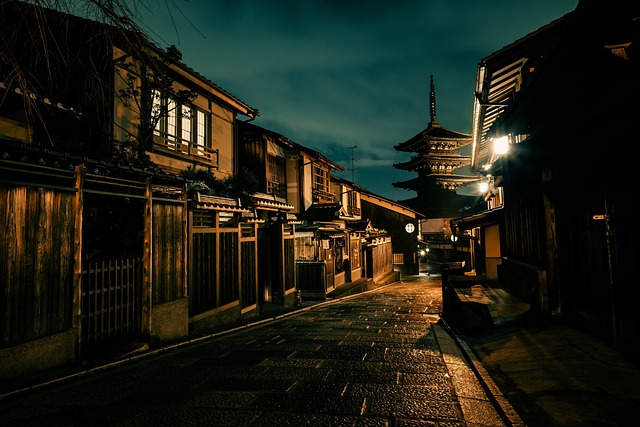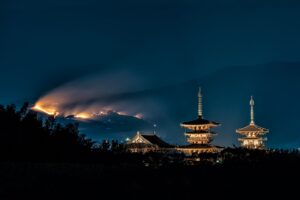Kyoto, Japan, is a city steeped in history, culture, and tradition. It served as the imperial capital of Japan for over a thousand years, from 794 until the capital was moved to Tokyo in 1868. As a result, Kyoto is home to numerous temples, shrines, palaces, and gardens, many of which are UNESCO World Heritage Sites. Kyoto is known for its well-preserved historical sites, including the famous Kinkaku-ji (Golden Pavilion), Ginkaku-ji (Silver Pavilion), Kiyomizu-dera Temple, and Fushimi Inari Taisha Shrine, famous for its thousands of torii gates. The city is a center for traditional Japanese culture, including tea ceremonies, kimono wearing, and flower arranging (ikebana). While the emperor and the imperial family moved to Tokyo with the Meiji Restoration in 1868, the Kyoto Imperial Palace remains an important cultural site. Visitors can tour the palace grounds and buildings. Kyoto is a must-visit destination for anyone interested in Japanese history, culture, and tradition. Its timeless beauty and rich heritage continue to enchant visitors from around the world.
Visitors can experience these traditions firsthand by participating in workshops or visiting cultural centers. Kyoto is beautiful year-round, but it’s particularly famous for its cherry blossoms in spring and vibrant autumn foliage. The city’s temples and gardens provide stunning backdrops for enjoying these seasonal phenomena. While steeped in tradition, Kyoto is also a modern city with bustling shopping streets, vibrant nightlife, and a thriving arts scene. The city seamlessly blends its historical past with contemporary culture.
Built in the 17th century, Nijo Castle is a UNESCO World Heritage Site and a prime example of feudal castle architecture. Its “nightingale floors” squeak to alert of intruders, and the gardens surrounding the castle are exquisite. Gion is Kyoto’s most famous geisha district, known for its traditional wooden machiya houses and tea houses. Visitors often stroll through Gion in hopes of catching a glimpse of geisha or maiko (apprentice geisha) hurrying to appointments. Just outside the city center lies the Arashiyama district, famous for its bamboo groves. Walking through these towering bamboo stalks is a serene and picturesque experience. Kyoto is renowned for its traditional cuisine, known as Kyo-ryori, which often emphasizes seasonal ingredients and subtle flavors. Dishes like kaiseki (multi-course meals) and tofu-based dishes are highlights.
Kyoto offers a plethora of attractions for tourists, ranging from historical landmarks to cultural experiences. Kinkaku-ji (Golden Pavilion): One of Kyoto’s most iconic sights, Kinkaku-ji is a Zen Buddhist temple with a stunning golden pavilion set amidst a serene pond and lush greenery. Fushimi Inari Taisha: Known for its thousands of vermillion torii gates leading up the mountain, Fushimi Inari Taisha is dedicated to Inari, the Shinto god of rice and prosperity. Visitors can hike through the gates to enjoy panoramic views of Kyoto. Kiyomizu-dera Temple: Perched on a hillside, Kiyomizu-dera offers sweeping views of Kyoto. The temple’s main hall, supported by wooden pillars, is a UNESCO World Heritage Site and a marvel of Japanese architecture. Arashiyama Bamboo Grove: Located in the Arashiyama district, the bamboo grove is a tranquil retreat where visitors can walk through towering bamboo stalks on winding paths. Gion District: Famous for its traditional machiya houses and teahouses, Gion is Kyoto’s geisha district. Visitors can wander its narrow streets, visit historic tea houses, and, if lucky, catch a glimpse of geisha or maiko. Nijo Castle: Built in the 17th century, Nijo Castle is a UNESCO World Heritage Site known for its exquisite gardens, ornate interiors, and “nightingale floors” designed to squeak and alert of intruders. Philosopher’s Path: A scenic walking trail along a canal lined with cherry trees, the Philosopher’s Path is especially beautiful during cherry blossom season, offering a peaceful escape from the city. Ryoan-ji Temple: Famous for its rock garden, Ryoan-ji is a Zen temple known for its minimalist design and tranquil atmosphere. Nishiki Market: Often referred to as “Kyoto’s Kitchen,” Nishiki Market is a bustling covered market offering a wide array of fresh seafood, produce, Kyoto specialties, and traditional snacks. Kyoto Imperial Palace: While the emperor and the imperial family moved to Tokyo in the 19th century, the Kyoto Imperial Palace remains an important cultural site. Visitors can tour the palace grounds and buildings.
10: GION HIGASHIYAMA

Gion, Higashiyama (geisha, Kiyomizu-dera, Shirakawa Lane, Kamo river) district is characterized by its well-preserved machiya houses, traditional wooden townhouses with narrow facades and long, deep interiors. Many of these machiya have been converted into restaurants, teahouses, and shops. Kiyomizu-dera Temple: Perched on a hillside, Kiyomizu-dera offers sweeping views of Kyoto. The temple’s main hall, supported by wooden pillars, is a UNESCO World Heritage Site and a marvel of Japanese architecture. Shirakawa Lane is situated in the heart of the Gion district, Kyoto’s historic geisha district. It is within walking distance of other popular attractions in Gion, such as Hanami-koji Street, where visitors can spot geisha and maiko (apprentice geisha) in their traditional attire.
Gion Higashiyama is a historic district in Kyoto, Japan, renowned for its preserved traditional atmosphere, charming streets, and significant cultural landmarks. Gion Higashiyama is one of Kyoto’s most famous geisha districts. Visitors can often spot geisha (known as geiko in Kyoto dialect) or apprentice geisha (maiko) adorned in elegant kimono, hurrying to appointments or performances. The district is characterized by its well-preserved machiya houses, traditional wooden townhouses with narrow facades and long, deep interiors. Many of these machiya have been converted into restaurants, teahouses, and shops. Gion Higashiyama is home to numerous teahouses and restaurants where visitors can experience traditional Japanese cuisine and tea ceremonies. Some establishments offer exclusive opportunities to dine with geisha or watch traditional performances.
Located at the eastern end of Shijo-dori, Yasaka Shrine is one of Kyoto’s most prominent Shinto shrines. It is especially popular during festivals such as the Gion Matsuri held in July, one of Japan’s largest and most famous festivals. One of Kyoto’s most important temples, Chion-in is the headquarters of the Jodo sect of Japanese Buddhism. The temple complex features impressive gates, halls, and gardens, including Japan’s largest temple bell. Adjacent to Yasaka Shrine, Maruyama Park is a popular spot for cherry blossom viewing (hanami) in spring. The park’s large weeping cherry tree (shidare-zakura) is illuminated at night during the cherry blossom season, creating a magical atmosphere. Founded in 1606, Kodai-ji is a historic Zen temple known for its beautiful gardens, bamboo groves, and stunning autumn foliage. The temple’s architecture and artworks are also noteworthy. A cultural center located in the heart of Gion, Gion Corner offers performances showcasing various traditional Japanese arts, including tea ceremony, flower arrangement (ikebana), traditional dance, and puppetry. Gion Higashiyama’s blend of history, culture, and natural beauty makes it a must-visit destination for travelers interested in experiencing the traditional charm of Kyoto. Whether wandering its atmospheric streets, attending a cultural performance, or admiring its historic landmarks, visitors are sure to find plenty to enchant and captivate them in Gion Higashiyama.
Sannenzaka, also known as Sannen-zaka, is a historic pedestrian street located in the Higashiyama district of Kyoto, Japan. It is famous for its preserved traditional atmosphere, charming architecture, and vibrant shops and eateries. Sannenzaka, along with its neighboring street Ninenzaka (“Two-Year Slope”), is lined with well-preserved machiya (traditional wooden townhouses) that date back to the Edo Period (1603-1868). The area retains the ambiance of old Kyoto, offering visitors a glimpse into the city’s rich history. The narrow, cobblestone streets of Sannenzaka are picturesque and evoke a sense of nostalgia. Walking along these streets feels like stepping back in time to old Japan. Sannenzaka is home to a variety of shops, cafes, and traditional craft stores selling souvenirs, ceramics, textiles, and other Kyoto specialties. Visitors can browse for unique gifts or enjoy a cup of tea at a traditional teahouse.
Several traditional teahouses and restaurants are nestled along Sannenzaka, offering authentic Japanese cuisine and tea experiences. Many of these establishments boast charming interiors and traditional tatami rooms. Sannenzaka serves as a gateway to some of Kyoto’s most famous attractions, including Kiyomizu-dera Temple, Yasaka Shrine, and Kodai-ji Temple. Visitors can explore these cultural landmarks on foot from Sannenzaka. The ambiance of Sannenzaka is particularly enchanting during cherry blossom season in spring and when the autumn leaves change color in fall. The street’s historic buildings, adorned with seasonal decorations, create a picturesque backdrop for leisurely strolls and photography.
Throughout the year, Sannenzaka hosts various cultural events and festivals, such as traditional music performances, tea ceremonies, and craft workshops. These events offer visitors opportunities to immerse themselves in Kyoto’s rich cultural heritage. Sannenzaka is a delightful destination in Kyoto, offering visitors a chance to experience the city’s traditional charm and beauty. Whether shopping for souvenirs, savoring local cuisine, or simply enjoying the ambiance of old Japan, Sannenzaka is sure to leave a lasting impression on visitors.
Shirakawa Lane, also known as Shirakawa Minami-dori, is a picturesque street located in the Gion district of Kyoto, Japan. It runs alongside the Shirakawa River and is famous for its tranquil atmosphere, traditional machiya houses, and beautiful willow trees. Shirakawa Lane is renowned for its scenic beauty, particularly during the cherry blossom season in spring and when the willow trees along the riverbank turn vibrant green in summer. The street’s serene ambiance and charming surroundings make it a popular spot for leisurely strolls and photography. The street is lined with well-preserved machiya, traditional wooden townhouses that date back to the Edo Period (1603-1868). These machiya feature distinctive architectural elements, such as latticed windows, wooden facades, and tiled roofs, adding to the street’s historic charm. Several restaurants and cafes with outdoor seating overlook the Shirakawa River, offering diners picturesque views of the water and surrounding greenery. Visitors can enjoy a meal or a cup of tea while taking in the tranquil atmosphere of the riverbank. Throughout the year, Shirakawa Lane hosts various seasonal events and festivals, including traditional music performances, art exhibitions, and cultural celebrations. These events attract both locals and tourists and showcase Kyoto’s rich cultural heritage.
Shirakawa Lane is situated in the heart of the Gion district, Kyoto’s historic geisha district. It is within walking distance of other popular attractions in Gion, such as Hanami-koji Street, where visitors can spot geisha and maiko (apprentice geisha) in their traditional attire. In the evenings, Shirakawa Lane is illuminated by traditional lanterns, creating a magical atmosphere along the riverbank. The soft glow of the la terns reflects on the water, enhancing the street’s beauty and enchantment after dark. Visitors to Shirakawa Lane can explore artisan workshops and galleries showcasing traditional crafts, such as pottery, ceramics, and textiles. These establishments offer unique handmade goods and provide insights into Kyoto’s artisanal traditions. Shirakawa Lane is a tranquil oasis in the bustling city of Kyoto, offering visitors a chance to immerse themselves in the beauty of traditional Japanese architecture and natural surroundings. Whether enjoying a riverside stroll, dining al fresco, or exploring local artisans’ creations, Shirakawa Lane provides a memorable experience for all who visit.
Hanamikoji-dori is a historic street located in the Gion district of Kyoto, Japan. It is renowned for its traditional architecture, teahouses, restaurants, and the presence of geisha and maiko (apprentice geisha) in their elegant attire. Hanamikoji-dori is one of the main thoroughfares in Gion, which is Kyoto’s most famous geisha district. Visitors to Hanamikoji-dori often have the opportunity to see geisha and maiko walking along the street or entering tea houses for their evening engagements. The street is lined with well-preserved machiya houses, traditional wooden townhouses that date back to the Edo Period (1603-1868). These machiya feature lattice windows, tiled roofs, and wooden facades, contributing to the street’s historic ambiance.
Hanamikoji-dori is home to numerous teahouses, restaurants, and upscale establishments where visitors can experience traditional Japanese cuisine and cultural performances. Some teahouses offer exclusive opportunities to observe geisha or maiko entertainment. Along Hanamikoji-dori, visitors can find exclusive shops selling traditional Japanese crafts, souvenirs, and specialty items. These shops offer a range of goods, including ceramics, textiles, fans, and kimono accessories. Hanamikoji-dori hosts various seasonal events and festivals throughout the year, including traditional tea ceremonies, lantern festivals, and cultural celebrations. These events provide visitors with opportunities to experience Kyoto’s rich cultural heritage firsthand.
Hanamikoji-dori is centrally located within the Gion district, making it a convenient starting point for exploring other nearby attractions, such as Yasaka Shrine, Kodai-ji Temple, and the Shirakawa River. In the evenings, Hanamikoji-dori takes on a magical ambiance, with traditional lanterns illuminating the street and casting a warm glow on the historic buildings. The street comes alive with the sound of footsteps, laughter, and occasional music from nearby teahouses. Hanamikoji-dori is a favorite spot for photographers seeking to capture the essence of Kyoto’s traditional culture. The street’s charming architecture, atmospheric lighting, and occasional sightings of geisha and maiko make it a popular subject for photographs. Hanamikoji-dori offers visitors a unique glimpse into Kyoto’s geisha culture, history, and traditional way of life. Whether exploring the street’s historic buildings, dining at a traditional teahouse, or simply enjoying the ambiance, Hanamikoji-dori provides a memorable experience for all who visit.
The kimono is a traditional Japanese garment known for its elegant and timeless design. The kimono’s origins can be traced back to the Heian period (794-1185) in Japan. Initially, it was a garment worn by both men and women, but over time, the style evolved, and distinct styles emerged for men and women.
A traditional kimono is a T-shaped garment with long, wide sleeves and a wrap-around design secured with a sash called an obi. Kimonos are typically made from silk or other high-quality fabrics and feature intricate designs, patterns, and motifs, often inspired by nature, seasons, or Japanese cultural symbols. There are various types of kimonos, each worn for different occasions and seasons. Formal kimonos, such as the furisode for unmarried women and the tomesode for married women, are often worn for special events like weddings and ceremonies. Casual kimonos, like the yukata, are worn during summer festivals and leisure activities. The obi is a wide belt or sash worn around the waist to secure the kimono. It is often elaborately tied in a decorative knot at the back. The style and design of the obi can vary depending on the formality of the occasion and the wearer’s age and status.
The kimono is deeply ingrained in Japanese culture and has symbolic significance. It is considered a form of art and an expression of Japanese aesthetics, embodying concepts such as simplicity, harmony, and beauty. While the kimono is no longer worn as everyday attire in contemporary Japan, it is still worn for special occasions, ceremonies, and cultural events. Many Japanese people also wear kimonos during traditional festivals and holidays. In recent years, there has been a revival of interest in the kimono both in Japan and around the world. Fashion designers and enthusiasts appreciate its timeless elegance and have incorporated elements of the kimono into modern clothing styles. The kimono is recognized as an important cultural heritage item by UNESCO. Efforts are being made to preserve and promote traditional kimono craftsmanship, including dyeing, weaving, and embroidery techniques.
Wearing a kimono involves specific etiquette and rules, such as how to properly fold and store the garment, how to tie the obi, and how to coordinate accessories. There are also guidelines regarding appropriate colors and patterns for different occasions. For tourists visiting Japan, kimono rental shops offer the opportunity to experience wearing a kimono and explore traditional Japanese culture. Many tourist destinations, especially in Kyoto, offer kimono rental services, allowing visitors to dress up and take photos in iconic locations. The kimono is a symbol of Japanese tradition, craftsmanship, and cultural identity, cherished for its beauty and significance both in Japan and worldwide.
References
- https://youtu.be/pOYVsgw7RhY
- https://en.wikipedia.org/wiki/Historic_Villages_of_Shirakawa-g%C5%8D_and_Gokayama
- https://wikitravel.org/en/Kyoto/Higashiyama
- https://www.japanesewiki.com/road/Hanamikoji-dori%20Street.html
- https://youtu.be/fUXW3BENjsQ
- https://youtu.be/wHhO7KvTxNg
- https://youtu.be/MhaZfaW6aI4
- https://youtu.be/3fT9sQpD3Gg
- https://youtu.be/KoUEQca_k9I
- https://youtu.be/pOYVsgw7RhY
- https://youtu.be/gDu0YPcfsYw (Expat Buying Houses)
- https://youtu.be/6DAw_ISEEcs (Expat Buying Houses)
- https://youtu.be/QBCg4VJzaNM
- https://youtu.be/E0RGeDPQ0NA
- https://youtu.be/UeJQMvydpzQ
- https://www.youtube.com/watch?v=NwU0KKSdJBM
- https://www.youtube.com/watch?v=25mwOfLiqOc
- https://www.youtube.com/watch?v=pRpvm7LzfrA
- https://www.youtube.com/watch?v=OI0F-zEhPJw (Kantara)
- https://www.youtube.com/watch?v=w_O77dWhyAM
- https://www.youtube.com/watch?v=7zVfPif-UZo
- https://www.youtube.com/watch?v=YSrhCEHyB0U
- https://www.youtube.com/watch?v=CG5Hh7DUTUQ
- https://www.youtube.com/watch?v=04wZNnjdURE (Japanese Habits)
- https://www.youtube.com/watch?v=_LqyqHDUyhg
- https://www.youtube.com/watch?v=YFhNH2KdG9k
- https://www.youtube.com/watch?v=B9He5DVePvk (Life of Amish in the US)
- https://www.youtube.com/watch?v=PoJc9l4-mJM (Geisha, Geiko, and Maiko)
- https://www.youtube.com/watch?v=7zVfPif-UZo
- https://www.youtube.com/watch?v=_LqyqHDUyhg
- https://www.youtube.com/watch?v=TWqy7l4OcPc
- https://www.youtube.com/watch?v=nE6s_e4TmEI
- https://www.youtube.com/watch?v=893L3Vd86Pg
- https://www.youtube.com/watch?v=6JFWKh5leAo (Habits)
- https://www.youtube.com/watch?v=IoFBSTuDKWM (Habits)
- https://www.youtube.com/watch?v=3_6R1elIIgI (Habits)
- https://www.youtube.com/watch?v=4ueZD6TAZso (Habits)
- https://www.youtube.com/watch?v=YZZpiYRO07o (Laws Versus Manners)
- https://youtu.be/oVFjA7Qy1as (Habits and Manners)




